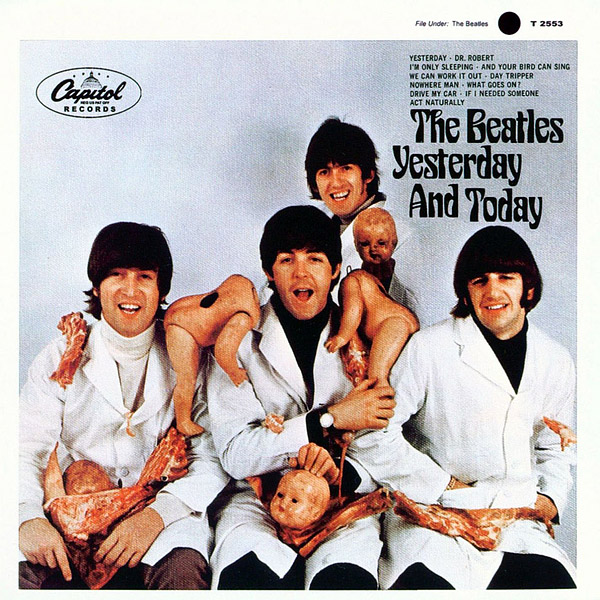
Friday, June 10, 1966
“Yesterday and Today” butcher cover is being withdrawn
Last updated on December 23, 2023

Friday, June 10, 1966
Last updated on December 23, 2023
Previous article Jun 05, 1966 • "Paperback Writer" and "Rain" broadcast on The Ed Sullivan Show
Session Jun 08, 1966 • Recording "Good Day Sunshine", editing "And Your Bird Can Sing"
Session Jun 09, 1966 • Recording and mixing "Good Day Sunshine"
Article Jun 10, 1966 • "Yesterday and Today" butcher cover is being withdrawn
Single Jun 10, 1966 • "Paperback Writer / Rain (UK)" by The Beatles released in the UK
Interview Jun 11, 1966 • Paul McCartney interview for Disc And Music Echo
Next article Jun 12, 1966 • The Beatles meet The Mamas & The Papas
Yesterday and Today (2014 reissue)
By The Beatles • Official album
Likely on April 29, 1966, The Beatles had an impromptu photo shoot with Robert Whitaker at Brian Epstein’s NEMS Enterprises offices in London. Whitaker used a blue steamer trunk as a prop, and took several photos of the band.
Around the same time, Capitol Records requested a photo for the cover of a new Beatles album they were assembling, to be named “Yesterday and Today“. Epstein sent them one of the photos from the steamer trunk session. Capitol’s art department quickly came up with a cover design, but this design was rejected by Brian Epstein.
Whitaker had recently taken photos of The Beatles dressed as butchers, holding raw meat and mutilated plastic baby dolls, for an art project. John Lennon insisted that one of these butcher photos be used for the cover, even though Epstein was opposed to the idea. Epstein was forced to submit the butcher photo to Capitol.
Capitol was reluctant to use the butcher photo, but Brian Epstein and The Beatles refused to change their minds. Capitol’s art department then designed a cover using the butcher photo. Epstein also decided to use photos from the butcher session to promote the single “Paperback Writer / Rain” in the UK press.
On June 3, the butcher photo was first printed in black and white in UK music magazines. On June 11, the magazine Disc And Music Echo published another photo from the butcher session in full colour on its front page, with the title “BEATLES: WHAT A CARVE-UP!” The picture attracted an unfavourable response from many of the magazine’s readers.
By June 7, in the US, 750,000 copies of the album with the butcher cover had been pressed, packaged, and shipped to distributors. However, Capitol began to receive consistent negative responses from its distributors and sales teams. Capitol’s president Alan Livingstone then decided to change the cover design, and Capitol’s art department designed a new cover using a “trunk” picture and the psychedelic font used on the butcher cover.
On June 10, Capitol launched “Operation Retrieve“, recalling all copies of the LP from distributors to replace the offending image, as well as items such as promotional posters.
Different strategies were pursued to deal with the 750,000 “butcher” covers. Some of the stock saw the records removed and the covers destroyed. For some of the stock, the new cover was pasted over the existing “butcher” cover.
On June 14, Capitol sent a memo to reviewers asking them to disregard the artwork and explaining that “The original cover, created in England, was intended as ‘pop art’ satire. However, a sampling of public opinion in the United States indicates that the cover design is subject to misinterpretation.“
The backlash against the butcher cover in the US was reported in the June 25 issue of Billboard. The cover controversy marked the first time that the Beatles’ judgment was criticised by the media and distributors.
“Yesterday And Today” was eventually released on June 20, just five days after the original release date.
Holding his cigarette lighter close to Whitaker’s sheet of transparencies, Epstein told me: “What I’d really like to do is set fire to the whole lot and never let them see the light of day.” I agreed wholeheartedly that the “butcher session” might well be disastrous to the career of any lesser band but I had to say that The Beatles were big enough to withstand the bad publicity. A year earlier, Epstein would have stood his ground and destroyed the transparencies. Like the rest of us, he was sickened by some of the stuff Whitaker had taken but he bent under pressure from John, chose one of the less offensive shots where The Beatles were grinning rather than sneering, and sent the transparency to Alan Livingston at Capitol. He released several other similar shots to EMI in London to use in press advertising for the new UK single which coupled ‘Paperback Writer’ and ‘Rain’ and he handed one to Disc And Music Echo, which published it in colour on the front cover of the June 11 issue.
In Hollywood, Livingston’s delayed reaction was that Capitol couldn’t use the “butcher session” picture although this meant recalling some “Yesterday… And Today” sleeves that had already been printed and put into circulation. The Capitol boss told Epstein bluntly that the dealers wouldn’t stock it and the sales people wouldn’t handle it. Advance copies sent to US media reviewers and deejays were scrapped and Ron Tepper, Capitol’s manager of press and information services announced that the artwork “created in England, was intended to bepop art satire”. The few copies of “Yesterday… And Today” with the original “butcher” cover became highly prized souvenirs and are valued at more than a thousand dollars in today’s memorabilia marketplace.
Tony Barrow – From “John, Paul, George, Ringo & me: the real Beatles story“, 2006
In those days you’d turn up at a session and the photographer would normally have an idea. In the very early days Dezo Hoffmann asked us to put glasses on. I said, ‘I don’t wear glasses, Dezo.’ He said, Yeah, but I’ll be able to sell these to eyeglass magazines all over the world.’ We were getting all these little clues of how it was done. So we were used to photographers giving us bizarre ideas, sometimes we’d ask why we should do it, and they’d say, ‘It’ll be OK,’ and we’d agree.
We’d done a few sessions with Bob before this, and he knew our personalities: he knew we liked black humour and sick jokes. It was very prevalent at that time. And he said, ‘I’ve had an idea – stick these white lab coats on.’ It didn’t seem too offensive to us. It was just dolls and a lot of meat. I don’t know really what he was trying to say, but it seemed a little more original than the things the rest of the people were getting us to do – eyeglasses!
He had a little history of doing that kind of shoot. I remember we came in once and he had some polystyrene that he wanted us to break, and he took action photos of us doing it. I suppose when the photos came out, it looked as if we were wrecking everything, but it was only because we were asked to do it as an idea for a photo session, and that’s what the ‘butcher’ cover was. So we liked it – we thought it was stunning and shocking, but we didn’t see all the connotations.
It was Capitol Records that didn’t want it, but you have to remember the climate then. I remember Sir Edward Lewis, head of Decca, not wanting the Stones’ album cover because it had graffiti on a toilet seat on it. Mick came round to talk to us about it, and I actually rang up Sir Edward and said that I thought they should put it out, but he wasn’t having any of it. We weren’t against a little shock now and then, it was part of our make-up.
Paul McCartney – From “The Beatles Anthology” book, 2000
I was mentioning to you off the air that the Yesterday and Today album, I always take the cover and I try and peel back…
Peel it to look for the dead babies bit, yeah.
How did that happen that that album cover never saw the light of day or, if it did, got pulled off fairly quickly?
We took the pictures in London at one of those photo sessions. By then we were really sort of beginning to hate it. A photo session was a big ordeal, and you had to try and look normal, and you didn’t feel it. And the photographer was a bit of a surrealist, you know? And he brought along all these babies and pieces of meat and doctors’ coats, so we really got into it, and that’s how we felt, eurgh! So we sort of — I especially — pushed for it to be an album cover, just to break the image, you know?
And it got out in America, and they printed… about sixty thousand got out, and then there was some kind of fuss, as usual, and they were all sent back in, or withdrawn. And they stuck that awful-looking picture which you have in front of you, of us sitting, looking just as deadbeat, but supposed-to-be-happy-go-lucky foursome.
You look very unhappy!
Yeah! Right, right! So we tried to, you know, do something different.
Album covers were much simpler then, right? Just the cover?
Yeah, you just walk in, take your photo, and walk out, you know? Especially in America, we made only, say, ten albums actually, in America there seem to be thirty of them. And so we would design a cover or have control of it, more of our own covers in England; but America always had more albums, so they always needed another picture, another cover.
John Lennon – From John Lennon on the Dennis Elsas Show, WNEW-FM, 28 Sept 1974.
The sleeve was great for us because we were quite a nice bunch of boys and we thought, Let’s do something like this!’ What was crazy about that sleeve was that, because it was banned, they glued paper over it and everyone started steaming it off. They made it into a really heavy collector’s item – which, I’m afraid to say, I don’t have a copy of, because in those days we never thought, ‘We’d better save this.’
Ringo Starr – From “The Beatles Anthology” book, 2000
The 1966 American album, Yesterday and Today, was the one with the controversial sleeve. I think Brian Epstein had met a photographer in Australia called Robert Whitaker, who came to London where Brian introduced him to us. He was avant-garde and took a lot of photographs. He set up a photo session which I never liked personally at the time.
I thought it was gross, and I also thought it was stupid. Sometimes we all did stupid things, thinking it was cool or hip when it was naive and dumb, and that was one of them. But again, it was a case of being put in a situation where one is obliged, as part of a unit, to co-operate.
So we put on those butchers’ uniforms for that picture. In the photograph we’re going, Ugh! That’s what I’m doing, isn’t it? I’m disgusted, and especially so by the baby dolls with their heads off. What the bloody hell is that all about? Quite rightly somebody took a look at it and said, ‘Do you think you really need this as an album cover? So the record company said: You don’t want to do a cover like that. We want to have a nice one with you all sitting in a little box.
George Harrison – From “The Beatles Anthology” book, 2000
What was your reaction to the furore around the sleeve?
I thought it was not my fault! If they had asked me what the artwork was I don’t think it would have been that frightening. I don’t blame people for being upset about it. But as it turns out it actually released John to say that they were pissed off looking like pretty little boys all the time and that they were human beings. It gave them a release.
Robert Whitaker – From An Interview with Robert Whitaker – Beatles in London, October 6, 2016
From The Beatles Butcher Cover – Yesterday and Today (rarerecords.net):
Replacement Cover Design
Capitol quickly came up with a replacement cover design; this one was much more innocuous and depicted the band surrounding a steamer trunk. This image may have been considered for use as the original cover of the album, and several different prototype cover slicks exist with slight variations on this image.
The decision then needed to be made as to what to do about the returned albums, that had the design that would soon be known as the “Butcher cover.” The decision regarding what to do about the covers may have been made at the corporate level or by individual plant managers.
At the Jacksonville, Illinois, plant, all of the returned copies had the records removed and the covers were reportedly taken to a landfill, where they were dumped into a hole that was then filled with water.
At the Los Angeles and Scranton plants, a different decision was reached – the cover slicks with the new artwork would be pasted over the existing “Butcher cover” slicks.
This process proved to be less expensive than reprinting the covers completely, but was also more time consuming. Not only was the process of precisely aligning a new slick over the old one a difficult task, but the finished covers also had to be trimmed at the mouth (the right edge) to account for any misalignment at the opening of the cover.
Once the covers were either reprinted (Jacksonville) or modified (Los Angeles and Scranton), the albums were again shipped to distributors for their June 20, 1966 release date. […]
Collectors and Butcher Covers
The fact that the original covers for Yesterday and Today were withdrawn and replaced wasn’t a secret, and the public soon discovered that many of them had purchased albums that had a cover with a second cover underneath. Not only that, but it was fairly easy to see the old cover under the new one on most copies, as the new cover was mostly white and the cover underneath was quite a bit darker. In addition, due to the haste with which the new slicks were applied to the old covers, many covers had trunk slicks that were slightly misaligned, making it even more obvious that there was another cover underneath the trunk cover.
A few enterprising individuals discovered that steam from a tea kettle could be carefully applied to the cover, which allowed the trunk slick to be removed and the Butcher cover underneath to be exposed. With time, the glue used to attach the trunk cover slicks became pretty secure, and attempts to peel the covers using steam became less successful, resulting in thousands of badly damaged and largely useless Butcher covers.
Within a few months, all of the “pasteover” copies of Yesterday and Today had been sold, and by the end of 1966, all of the copies seen in stores were copies that had been manufactured with the trunk cover only.
Butcher Cover Terminology
By January, 1967, four distinctly different versions of Yesterday and Today were in existence. These were the original issues with the “Butcher cover” photo, the second version of the album, with the trunk cover slick pasted over the Butcher cover, the buyer-created “peeled” versions with the trunk cover removed, and the fourth version, which was manufactured with the trunk cover slick.
While all versions of the album are currently sought out by collectors, the first issues are unquestionably the most prized and the most valuable. The second issue is also quite valuable, and the third issue may or may not be, depending on condition. The fourth version is of interest only to hard-core Beatles collectors and people who simply like the Yesterday and Today album, which, the opinion of the Beatles themselves notwithstanding, is a pretty good collection of songs. […]
From Wikipedia:
Collectability
The original LP sleeves for Yesterday and Today were assembled at Capitol’s four US plants situated in different cities: Los Angeles, California; Scranton, Pennsylvania; Winchester, Virginia; and Jacksonville, Illinois. Numbers designating where the covers originated were printed near the RIAA symbol on the back; for example, stereo copies from the Los Angeles plant were designated “5” and mono Los Angeles copies were marked “6”. Mono copies outnumbered stereo copies by about ten to one, making the stereo copies far more rare and valuable to collectors. Capitol initially ordered plant managers to destroy the covers, and the Jacksonville plant delivered most of its copies to a landfill. However, faced with so many jackets already printed, Capitol decided instead to paste the replacement cover over the old ones. The new cover had to be trimmed on the open end by about 3 mm (1/8 inch) because the new sheet, known as a “slick”, was not placed exactly “square” on top of the original cover. Tens of thousands of these so-called ‘trunk covers’ were sent out. As word of this manoeuvre became known to the public, owners of the altered cover attempted, usually unsuccessfully, to peel off the pasted-over cover, hoping to reveal the original image hidden beneath. Eventually, the soaring value and desirability of unpasted-over ‘butcher covers’ spurred the development of intricate and complex techniques for peeling the ‘trunk cover’ off in such a way that only faint horizontal glue lines remained on the original cover.
Copies that have never had the white cover pasted onto them, known as “first state” covers, are very rare and command the highest prices. Copies with the pasted-on cover intact above the ‘butcher’ image are known as “second state” or “pasteovers”. Today, “pasteover” covers that have remained unpeeled are also becoming increasingly rare and valuable; these can be identified if Ringo Starr’s black V-neck shirt from the original cover can be seen through the paste-over to the right of the trunk lid (in alignment with the word “Today” from the album title). Covers that have had the ‘trunk cover’ removed to reveal the underlying ‘butcher’ image are known as “third state” covers; these are now the most common (and least valuable, although their value varies depending on how well the cover is removed) as people continue to peel second state covers. The most valuable and highly prized first and second state ‘butcher covers’ are those that were never opened and remain still sealed in their original shrink-wrap. Since the first documented collector’s sale of a mono “butcher cover” LP in 1974, which fetched US$457.00, the value of first state mono versions has consistently appreciated, reaching $20,000 in 2006.
In 1987, Alan Livingston released for sale 24 “first state” butcher covers from his private collection. When the original cover was scrapped in June 1966, Livingston took a case of already-sealed ‘butcher cover’ albums from the warehouse before they were to be pasted over with the new covers, and kept them in a closet at his home. These albums were first offered for sale at a Beatlefest convention at the Marriott Hotel near Los Angeles International Airport on Thanksgiving weekend 1987 by Livingston’s son. These still-sealed pristine items, which included nineteen mono and five stereo versions, are the very rarest and most valuable ‘butcher covers’ in existence. These so-called “Livingston Butchers” today command premium prices among collectors, the five stereo versions being the most rare and valuable of these. In April 2006, Heritage Auction Galleries sold one of the sealed mono “Livingston Butchers” at auction in Dallas for close to $39,000.
An extremely rare original “first state” stereo copy that was not from the Livingston collection was presented for appraisal at a 2003 Chicago taping of the PBS series Antiques Roadshow. It was still in the possession of the original owner, who had bought it at Sears & Roebuck on the day of release in 1966 – the only day that the original ‘butcher cover’ versions were on sale before being recalled by Capitol. Although not in its original shrink-wrap, it had rarely been played and was still in excellent condition, and Roadshow appraiser Gary Sohmers valued it at US$10,000–$12,000. In 2016, a mint condition “first state” stereo copy of Yesterday and Today in shrink-wrap was sold for $125,000.
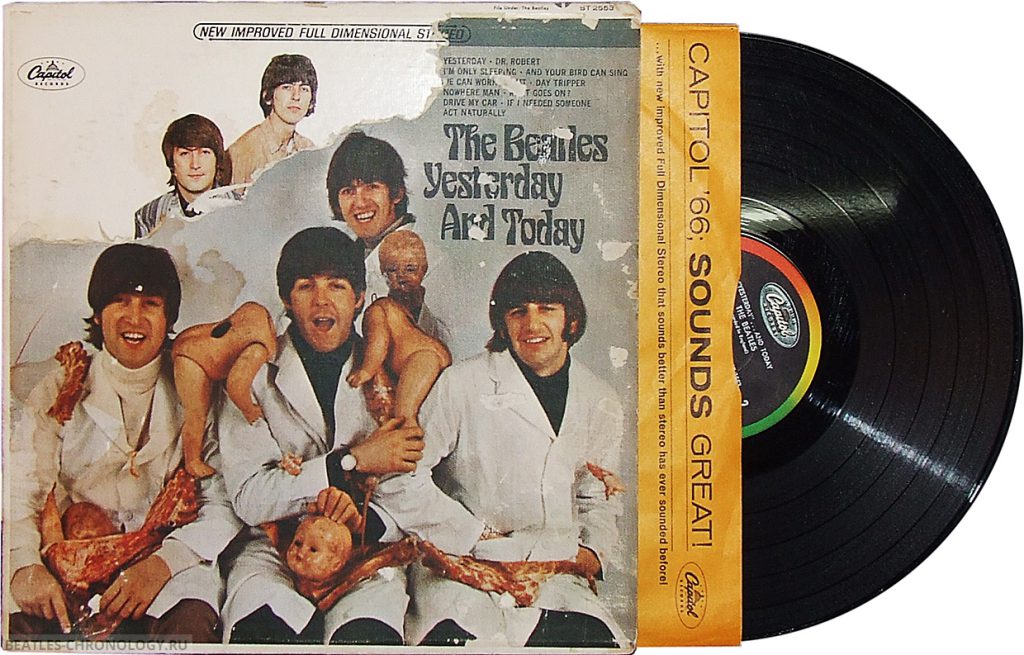
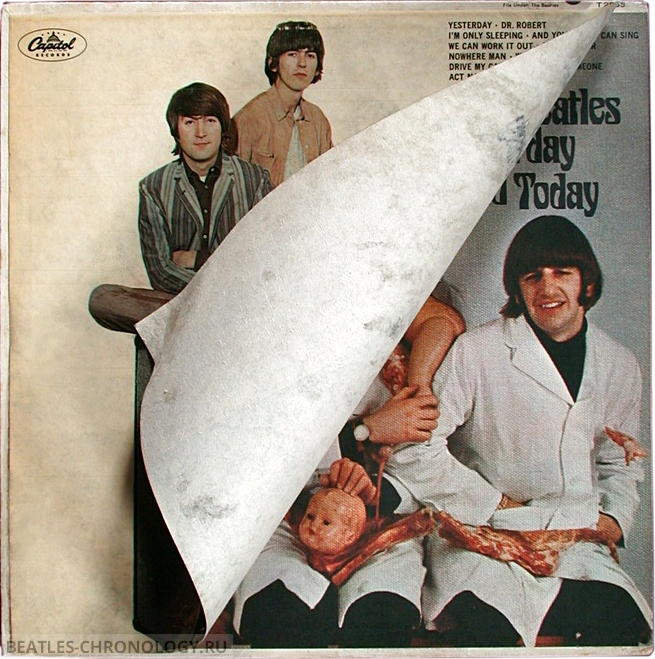
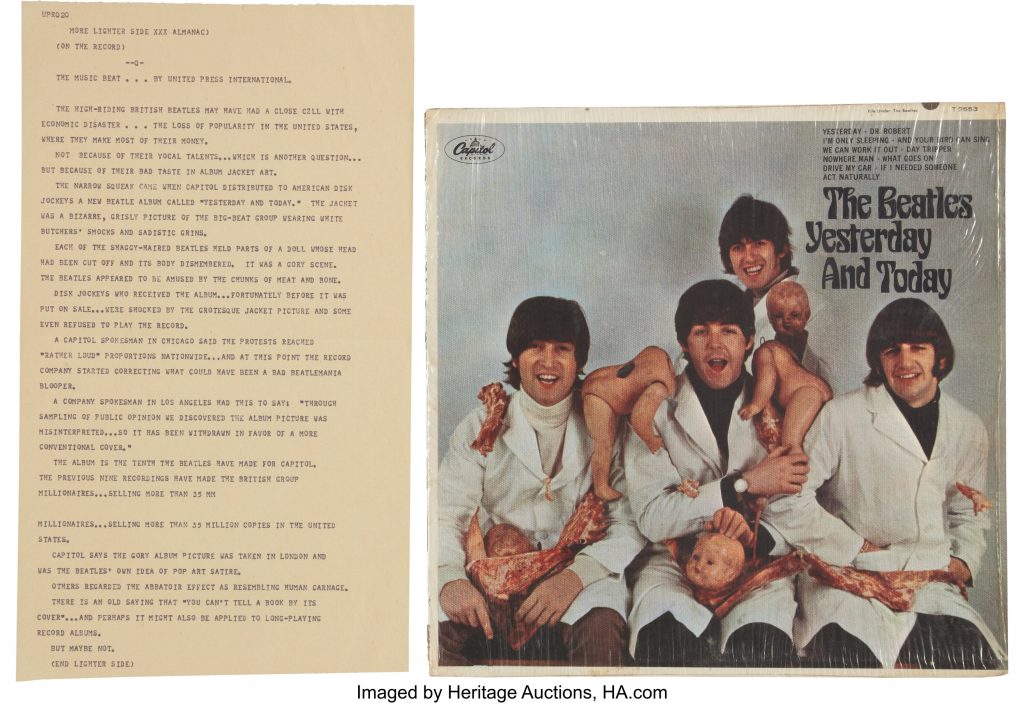
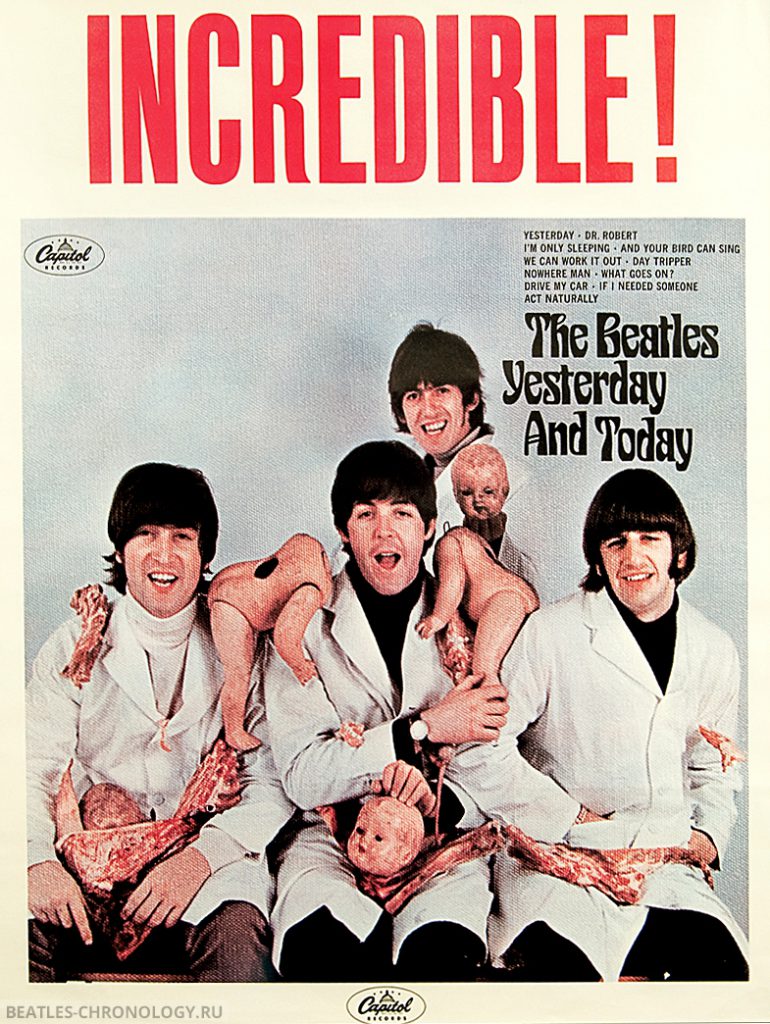
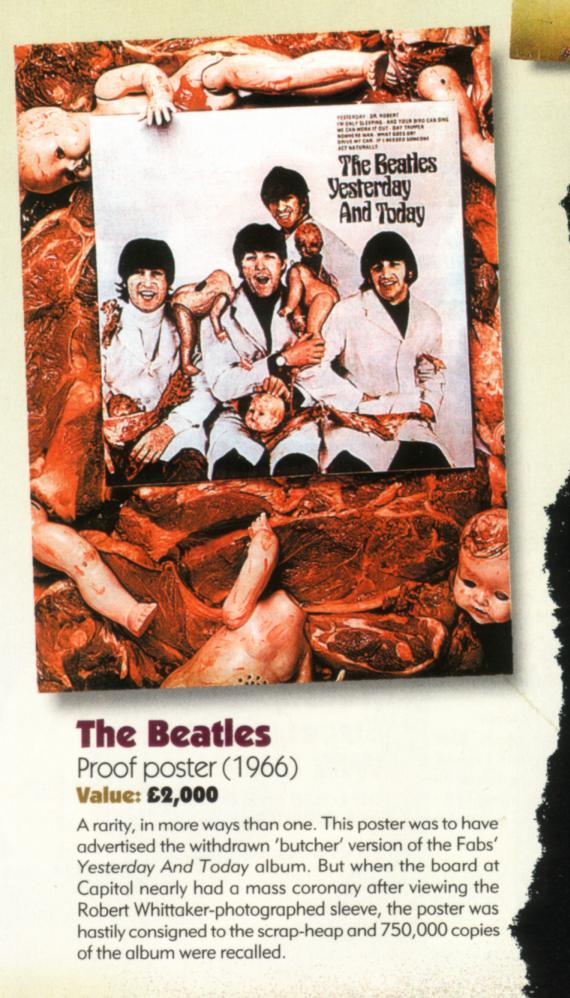
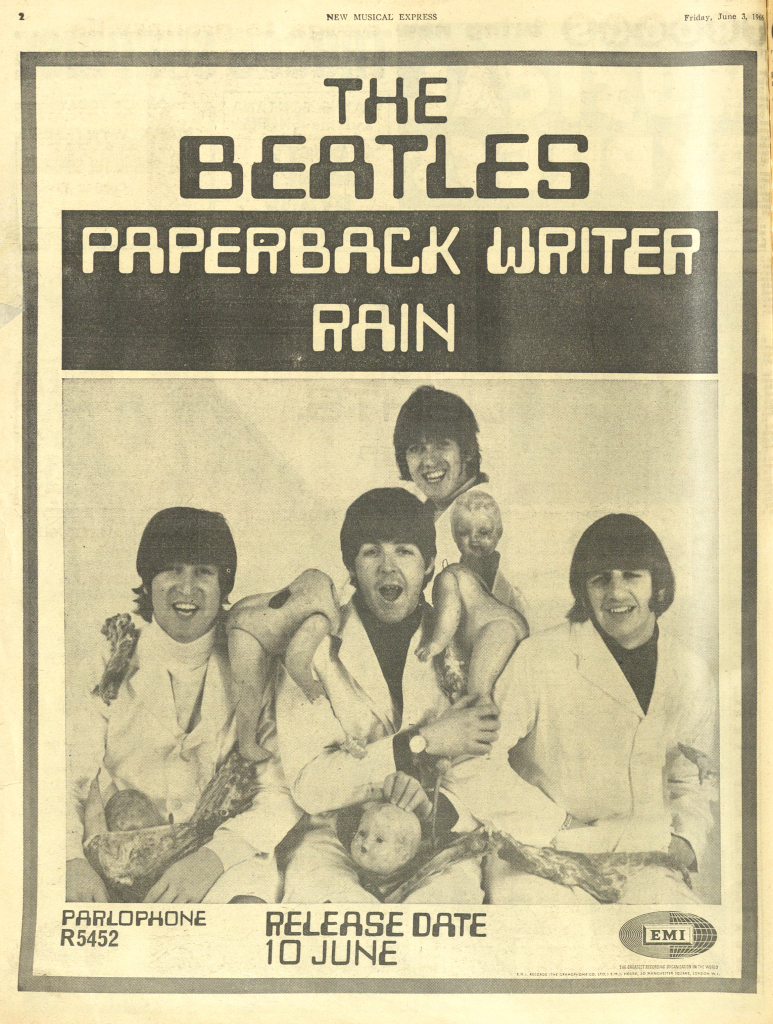
BEATLES: WHAT A CARVE-UP!
BEATLES WEEK! They’re back with a single, “Paperback Writer” and “Rain” — out tomorrow (Friday).
BUT WHAT’S THIS? The Beatles as butchers, draped with raw meat! Disc and Music Echo’s world exclusive colour picture by Bob Whitaker is the most controversial shot ever of John, Paul, George and Ringo.
THE PLACE: A private studio in Chelsea, London. Whitaker is taking some new pic-tures of the Beatles, and decides that a new approach is needed.
“I wanted to do a real experiment — people will jump to wrong conclusions about it being sick,” says Whitaker. “But the whole thing is based on simplicity — linking four very real people with something real. I got George to knock some nails into John’s head, and took some sausages along to get some other pictures. Dressed them up in white smocks as butchers, and this is the result — the use of the camera as a means of creating situations.“
PAUL’S comment after the session: “Very tasty meat.“
GEORGE: “We won’t come to any more of your sick picture sessions.“
JOHN: “Oh. we don’t mind doing anything.” RINGO: “We haven’t done pictures like THIS before…“
Well, what’s YOUR verdict? Sick — or super? Six LPs for the best six captions — of no more than 12 words — to the picture above. Send your entry to “Beatles Picture” Disc and Music Echo, 161 Fleet Street, London. E.C.4, before next Friday, June 17.
From Disc And Music Echo – June 11, 1966
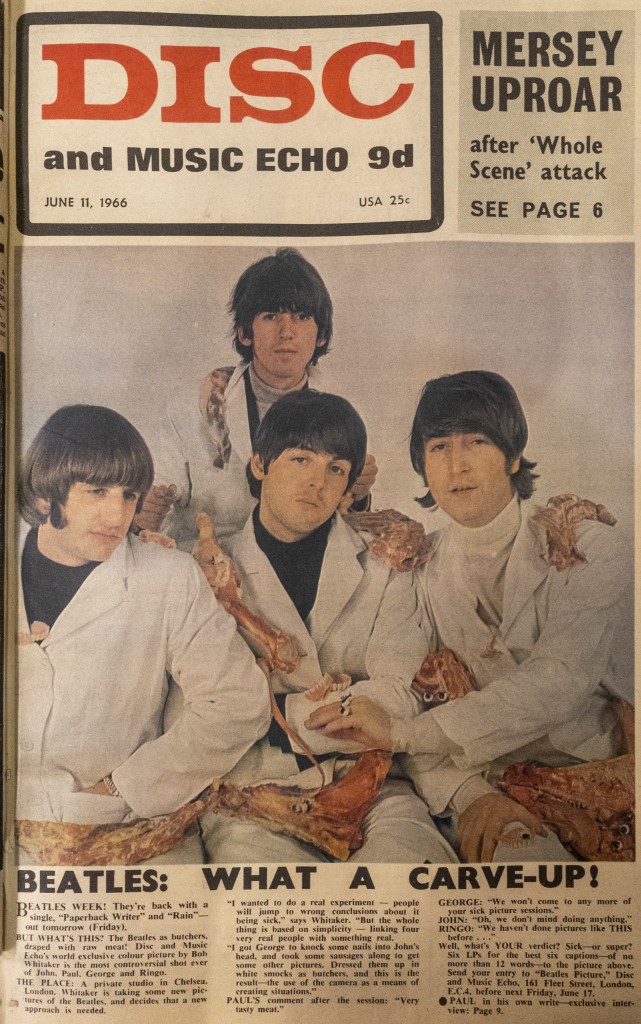
FANS SLAM ‘SICK ‘BEATLES PICTURE
OH dear! That front-page full-colour picture of the Beatles “in the raw” last week certainly triggered off some harsh comments from readers.
Remember-Disc and Music Echo printed an exclusive photo by Bob Whitaker showing John, Paul, George and Ringo dressed as butchers and draped with slabs of raw meat.
It was certainly an eye-catcher. But some readers thought it was just too much of an eyeful!.
Here are just some sample comments from letters that have been flooding in since Disc and Music Echo hit the news-stands.
ANNE HARDINGHAM, Allen Club, Hurst Grove, Bedford, Beds. – Help! Beatles victims of sick photography.
JOAN WILD, Junction Hotel, Leeds Road Bradford 1, Yorkshire. – How disgusting! And Paul writes about “gimmicks.” How strange of the Beatles to sit for a photograph like this. As from now on, I am a vegetarian
PETER TURLEY, 30 Ollard Avenue, Wisbech, Cambs. – There is only one caption for your picture, and that is; “The revolting side of ” the Beatles-sick, sick, sick.”
MRS. J. D. JONES, The Georgian House, 203 Topsham Road, Exeter, Devon. – The Beatles’ reputation is risked by indulging in this kind of disgusting publicity, But then. “one man’s meat is another man’s poison.”
VALERIE FOX, 49 Balsam Fields, Wincanton, Somerset. – It’s a horrible picture and a sick idea. I love the Beatles and was sorry to see them in a photo like this.
PAT NOBLE 8 Malpas Road, Dagenham, Essex. – Super! It can’t be anything else. All their pictures are really fantabulous.
D. de ROGARIEUX, 38 Midland Terrace, Harlesden, London, N.W.10. – It shows harmony, loyalty and perfect understanding of each other. It’s super.
LINDY M. PRINCE, 31 Ludlow Drive, West Kirby, Wirral, Cheshire. – Any civilised cow would die of fright if it saw that picture.
PAULINE PRICE, 2 Hedl Hyfryd, Gwersyllt, Wrexham, North Wales,- It’s great! What’s wrong with meat? We see it and cat it every day. It has a certain atmosphere about it!
From Disc And Music Echo – June 18, 1966
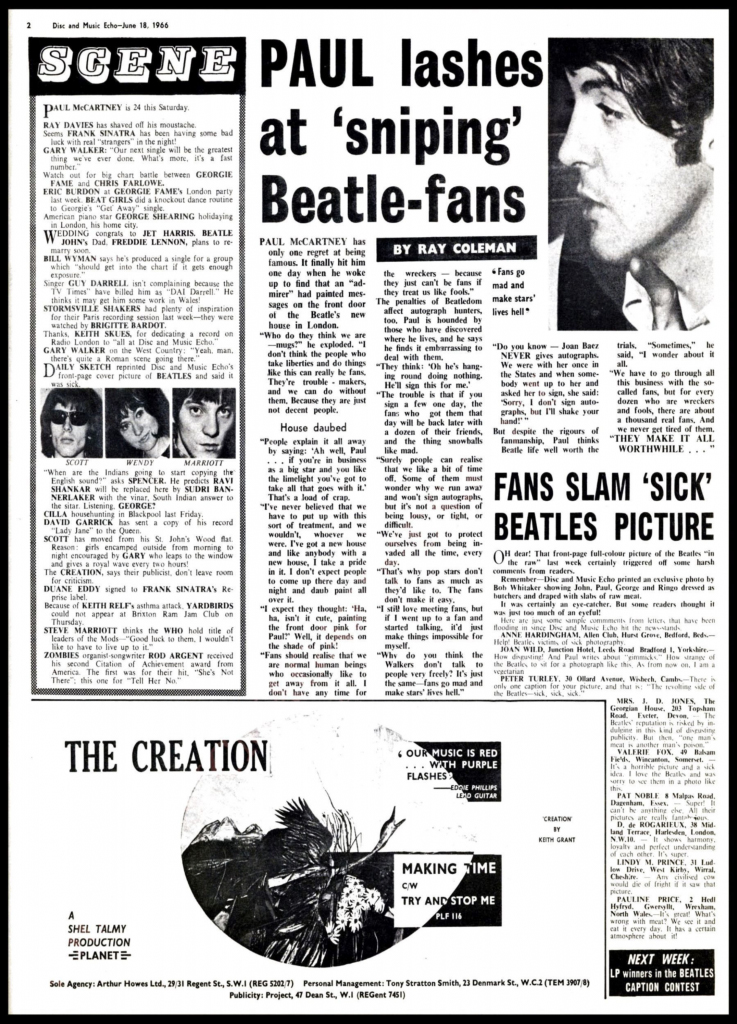
June 14, 1966
Dear Reviewer:
In the past few days, you may have received an advance promotional copy of The Beatles’ new album, “The Beatles Yesterday And Today.” In accordance with the following statement from Alan W. Livingston, President, Capitol Records Inc., the original album cover is being discarded and a new jacket is being prepared:
“The original cover, created in England, was intended as ‘pop art’ satire. However, a sampling of public opinion in the United States indicates that the cover design is subject to misinterpretation. For this reason, and to avoid any possible controversy or undeserved harm to The Beatles’ image or reputation, Capitol has chosen to withdraw the LP and substitute a more generally acceptable design.”
All consumer copies of The Beatles’ album will be packaged in the new cover, which will be available within the next week to 10 days. As soon as they are, we will forward you a copy. In the meantime, wo would appreciate your disregarding the promotional album and, if at all possible, returning it, C.O.D., to Capitol Records, 1750 N. Vine Street, Hollywood, Calif 90028.
Thank you in advance for your cooperation.
Ron Tepper. Manager. Press & Information Services
From Recording Here, There And Everywhere – The Beatles History (beatles-chronology.ru)
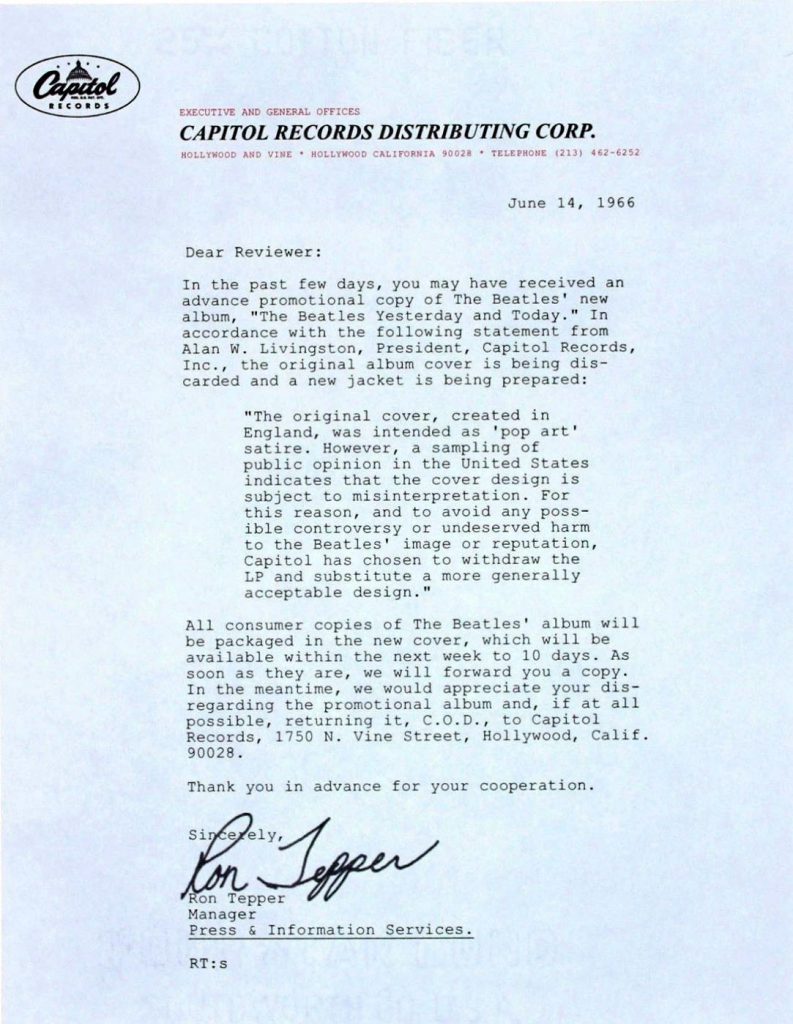
Beatles LP Makes Cap. Run for Cover
NEW YORK — Salesmen of the various Capitol Records Distributing Corp.’s branches throughout the nation are re-cuperating from a busy week-end — spent stripping the latest Beatles album, “The Beatles Yesterday and Today.”
Some 750,000 albums which were pressed, packaged and shipped to the factory branches have been recalled for repack-aging. Reason for the recall is the cover art — which shows the Beatles in white smocks sur-rounded by what appears to be dismembered baby dolls and butcher shop cuts of meat.
According to reliable reports, none of these albums have
reached dealer shelves, although some have been received by reviewers and rack jobbers. Capitol has a new cover printed, showing four nearly neatly dressed Beatles inside and draped around a trunk.
Alan W. Livingston, president of Capitol Records, explained the cover recall:
“The original cover in England was intended as ‘pop art’ satire. However, a sampling of public opinion in the United States indicates that the cover design is subject to misinterpretation. For this reason, and to avoid any possible controversy, or undeserved harm to the Beatles’ image or reputation. Capitol has chosen to withdraw the LP and substitute a more generally acceptable design.”
Meanwhile. Capitol is making a painstaking effort to recall the covers to make sure they are destroyed. Reviewers are requested to return the cover to Capitol, and dealers who have received streamers are asked to hold them until a salesman calls.
Some 90,000 albums were shipped to the New York branch alone, and the salesmen spent Saturday (11) and Sunday (12) stripping the albums before shipping them back to the Scranton, Pa., pressing plant for repackaging.
Capitol is going for a bundle on the deal. Figuring the album cover cost at 15 cents, 750,000 would come to $112,500. Add to that the cost of shipping the records back to the pressing plant, the labor involved in stripping, and the figure could reach $200,000.
Locally, cuts from the album had been getting airplay on WMCA, and extensive radio promotion had been launched.
From Billboard – June 25, 1966
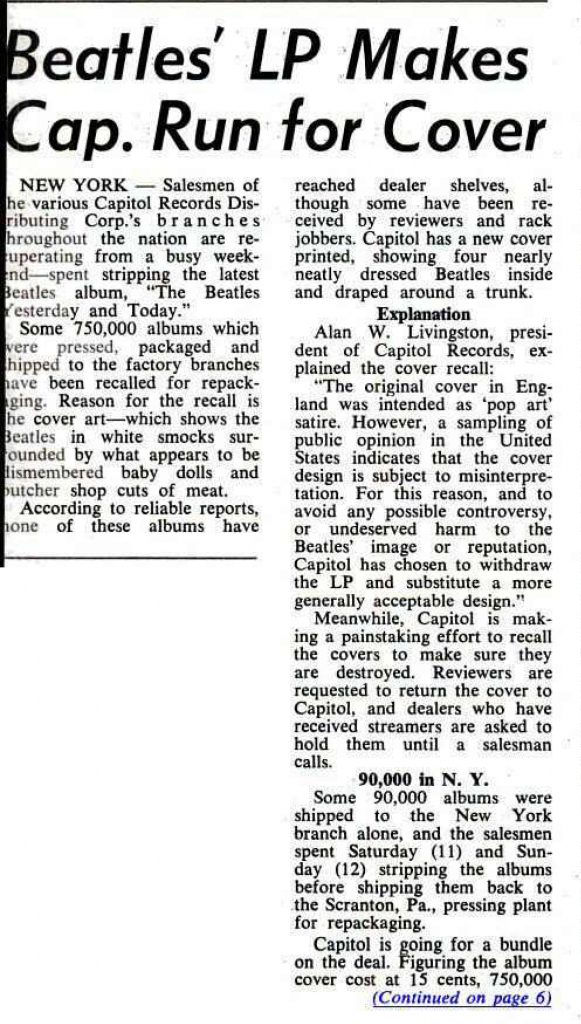
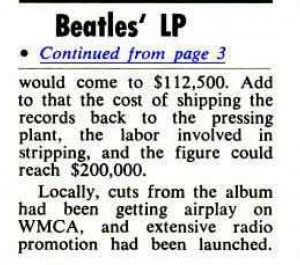
SUBJECT: DESTRUCTION OF OLD BEATLES JACKETS (S)T2553
Dear Bob:
This memo will certify that the destruction of 50,700 T2553, Beatles jackets, was completed on Monday, June 27, 1966. About 35,000 were destroyed on Friday, June 24, and the balance on Monday.
Destruction was accomplished by having a hole dug by a clam shovel in a swampy part of the Needham Town Dump. By the time the hole was ready for us it had filled with water. The jackets were dumped on the ground as close as possible to the hole and then a bulldozer pushed the jackets into the hole. The hole was then covered with about one to two feet of dirt and will subsequently be covered with garbage which will be well compacted as time goes by.
The supervisor of the Town Dump has promised that there will be absolutely no digging of any sort at the burial site and I will make checks from time to time to see that those instructions are followed.
If you desire any further Information with respect to this matter, please let me know.
Amen!
Cordially,
Joe Sobeck
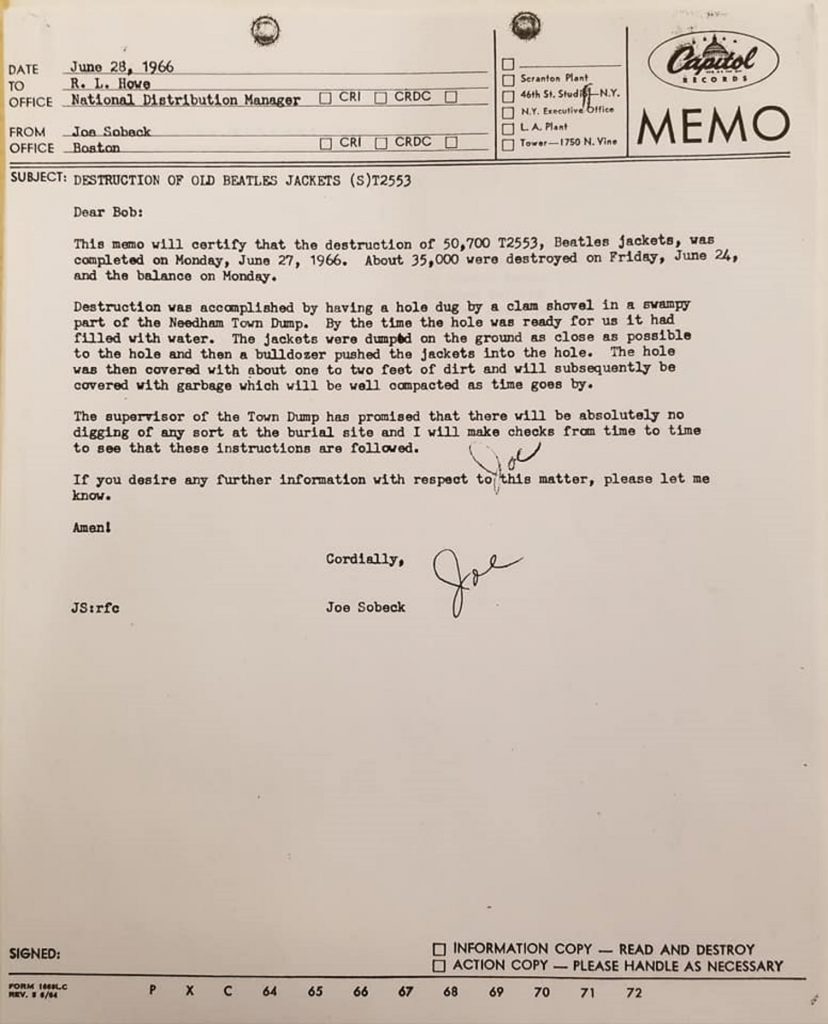
BUTCHER RECOLLECTION
I was Distribution Center Manager for Capitol Records in Boston at the time of the release of the “Beatles Butcher” album (S)T-2553 in June 1966.
The release of this album was shrouded in secrecy, primarily to prevent uneven distribution, which had plagued previous releases of Beatle product. The idea was to have ample quantities of the album available at all distribution centers at release date. Initial production was confined to the Jacksonville, Illinois factory.
Since Boston distribution center was furthest from Jacksonville, the Tower decided that Boston would get the first shipment of the album. Since timing was critical, the Tower decided to make Boston’s shipment via air.
So, an air freighter was chartered in St. Louis. After the plane left St. Louis all hell broke loose. The Beatles/Capitol management decided that the album jacket was not suitable for sale and would be withdrawn. Consult the Beatles Anthology for a good explanation of how this decision was reached.
The decision to recall the album was communicated to me and secrecy was still to be maintained due to the “sensitive nature of the situation”.
Apparently, relations between Capitol and the Beatles manager, Brian Epstein had begun to deteriorate and Capitol did not want this situation make things worse. The records would be separated from the offending covers and a new cover (Trunk Cover) would be shipped to us to be re-assembled and wrapped. Only Capitol employees would be allowed to do this stupendous job, so all Capitol field personnel were ordered to assemble in Boston. This meant sales and promotion people from Hartford, Albany, Rochester, Syracuse, Buffalo and Portland had to come to Boston on a Friday. Temporary help personnel were told there would be no work, even though they knew we were planning to work Saturday and Sunday.
Since we were shipped 50,700 albums, I pointed out to Hollywood that this jacket exchange would not be done in 2 days. It could take weeks. Example: With the primitive shrink-wrapping equipment in Boston, only about 500 albums could be wrapped in an 8 hour shift. It would take 101 days to do the job if everything went right. Crazy!!!!
It was decided that we would remove the vinyl disc and its inner sleeve and keep the records intact in the shipping carton to facilitate re-boxing. The polywrapping had to be cut just right so as to not injure the sleeve or disc. We did not care about the cover or the shrink-wrap as this was going to be scrapped. The new jackets were to be available within a week. The biggest problem was that 25 records without jackets do not make a solid carton that can be stacked on a pallet. It was like handling “jello”. We started out with about 31 pallets of records and after processing we now had 62 pallets of “jello” plus about 20 pallets of empty jackets. All this material had to be stored in the warehouse aisles which made movement in the warehouse limited at best. Chaos ruled!!
I protested to my supervisors in the Tower about the stupendous job they were expecting of me, but to no avail. They made me feel that my job was on the line so I just kept soldiering on even though I did not like it.
Now comes the good stuff.
The air freighter was delayed and did not land in Boston until 10 AM on Saturday instead of Friday afternoon. Then the unloading mechanism on the plane malfunctioned and the pallets of records could not be unloaded. Remember, we had about 30 people, including the field people, sitting around all day with nothing to do but play cards and eat pizza. The first shipment from the airport arrived about 4 PM, but by this time everybody was demoralized, so I sent everybody home to return on Sunday to start the job.
About 1/2 of the records were separated on Sunday and it really was not finished until 2 or 3 days later.
I continued to protest to the Tower that re-assembling and shrink-wrapping the albums was really a factory-type job and not something that could be done efficiently with the primitive equipment and labor available at our distribution center. Another hitch developed when I learned the new album cover would not arrive as promised, as preference was given to the factories which could produce complete albums a lot faster.
We remained in limbo for a few more days and then the Tower finally realized my predicament and decided to have me ship the separated albums to the Scranton factory for assembly into the new covers. Happy Day!!!
Now the problem was the disposal of the Butcher Covers, all 50,700 of them. The Tower still demanded that tight security be maintained and under no circumstances were those covers to be availabe to anyone. The Tower insisted the covers be destroyed somehow and left the method up to me, as long as security was maintained.
Incineration was the first choice, but local installations flatly refused because the volume involved would mess up their schedules. Shredding was not possible since nobody had equipment to handle the job.
Since these covers were a legitimate result of a town business and the town had to accept our “garbage” I decided that the town dump was the only feasible method of disposal, but maintaining security was still the main problem.
After consulting with the town dump supervisors, they agreed to take the covers and maintain security. It is amazing what spreading around a few hundred dollar bills can accomplish. Also, had the help of a local building contractor who introduced me and my problem to the town dump supervisor.
The dump people used a drag crane to dig a big hole in a swampy part of the dump. This hole filled with water so our truck could not get near enough, so a bull-dozer was used to push the cartons into the hole.
About 35,000 covers were dumped on a Friday, 6-24-66, the balance dumped on Monday 6-27-66. As soon as the dumping was completed each day the bulldozer covered the cartons with dirt fill.
Not surprisingly, what we were doing leaked out and that week-end one of the local radio stations announced as a joke, that you could get free Beatle albums at the town dump. A quick call to the station stopped all this talk, especially since I did threaten them that they would not ever get anymore Capitol product. The town dump was fenced and was closed most of the week-end, so security was maintained. I checked several times and was satisfied that our mission was accomplished as planned.
The Tower wanted documentation that the covers were destroyed and that is why the memo dated June 28, 1966 was sent.
The “Amen” at the end of the memo was only a small indication of the relief
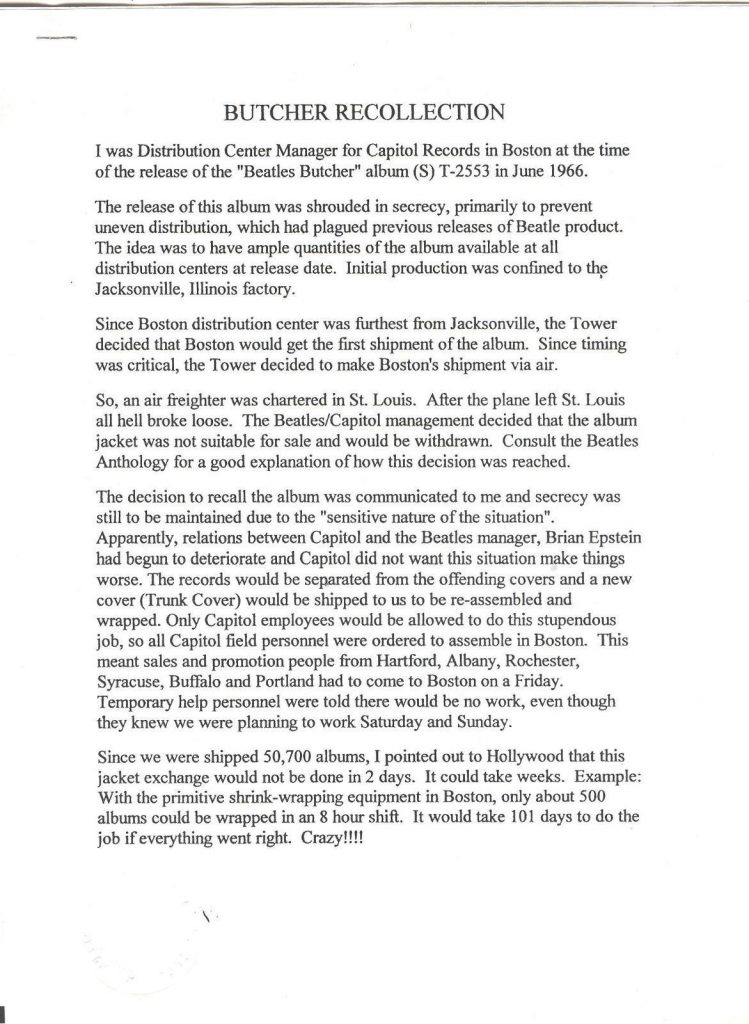
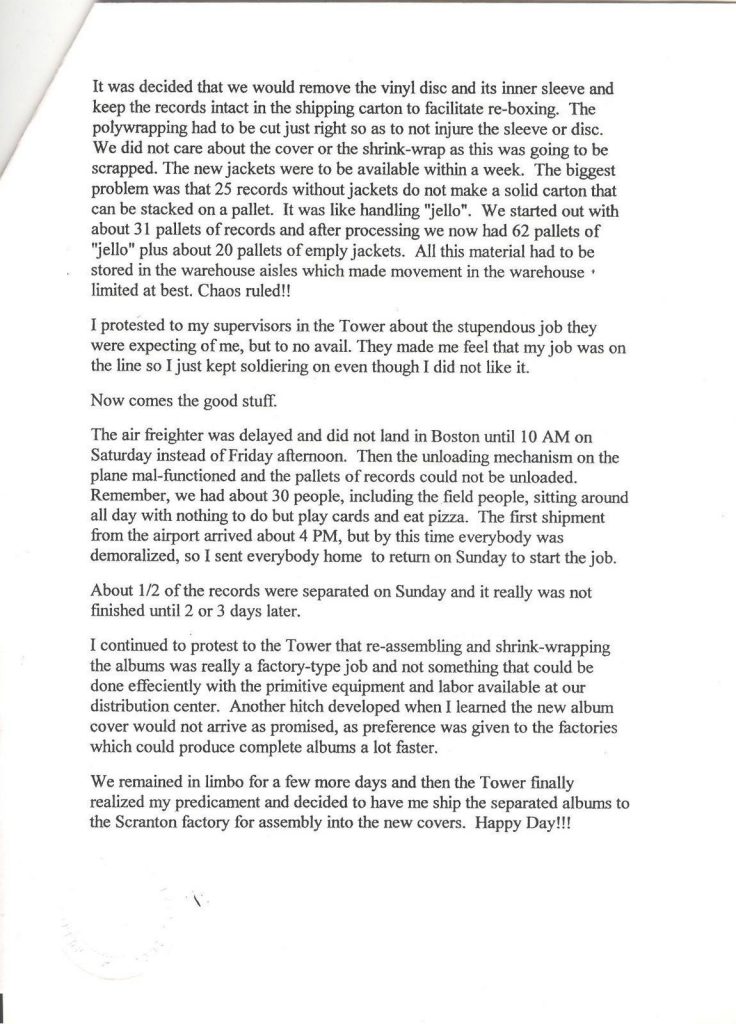
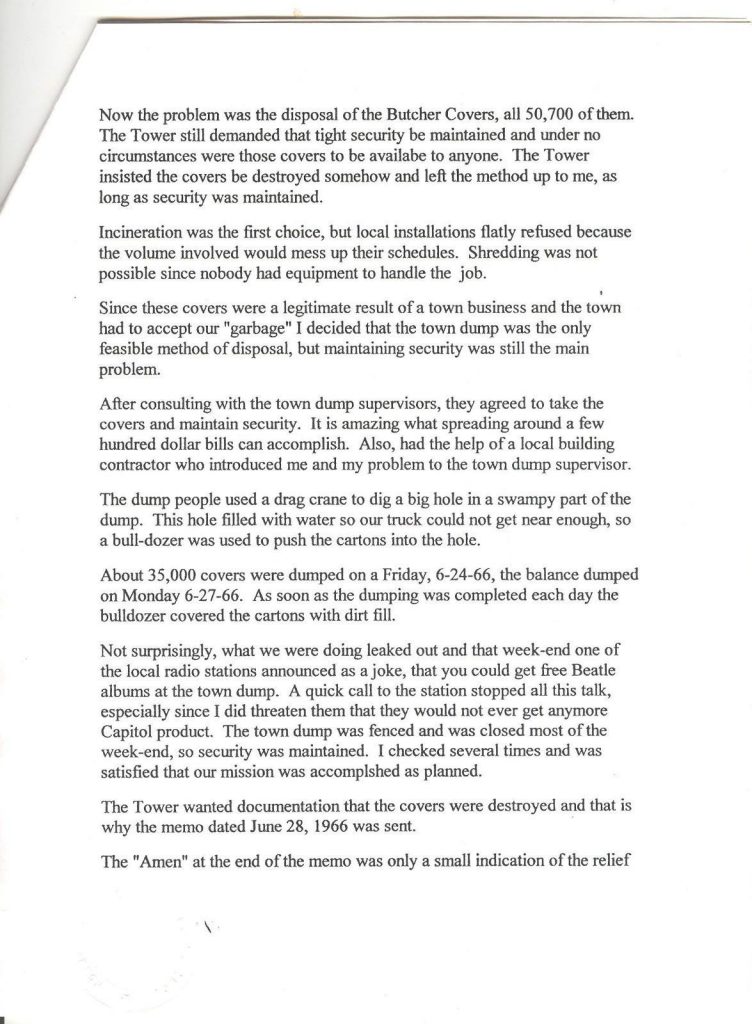
January 15, 1987
To Whom It May Concern:
I was President and Chief Executive Officer of Capitol Records from 1960 to 1968, and personally signed the Beatles to the Capitol label.
When “The Beatles Yesterday And Today” album was recalled, I kept some copies for my personal collection, and have given a few to my son, Peter Livingston, to dispose of as he wishes.
Please be assured that any album that Peter shows you is from my private collection, and is in its original shrink wrapped condition. You should, therefore, feel absolutely confident of its authenticity. I am confident that these albums are among the few, if not the only, genuine remaining editions, in mint condition, and hope that you will treat and respect them accordingly.
Sincerely,
Ian Livingstone
From Beatles “Yesterday And Today” Livingston Copy Sealed First State | Lot #21508 | Heritage Auctions (ha.com)
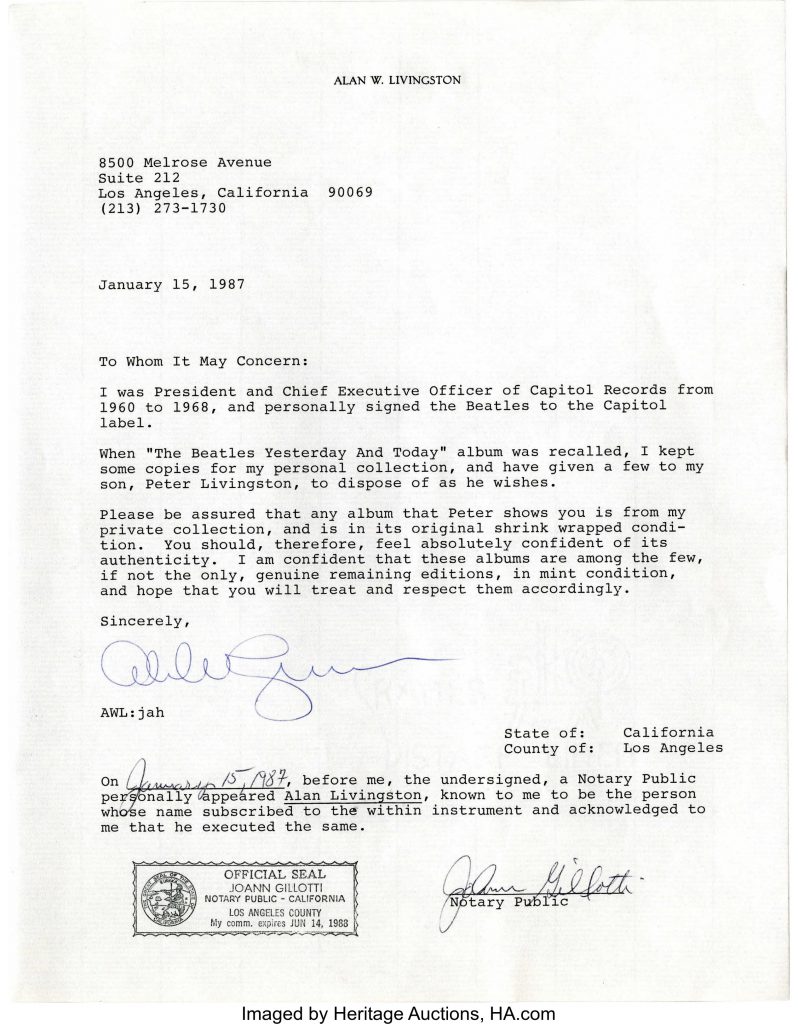
The Beatles Diary Volume 1: The Beatles Years
"With greatly expanded text, this is the most revealing and frank personal 30-year chronicle of the group ever written. Insider Barry Miles covers the Beatles story from childhood to the break-up of the group."
We owe a lot to Barry Miles for the creation of those pages, but you really have to buy this book to get all the details - a day to day chronology of what happened to the four Beatles during the Beatles years!

Notice any inaccuracies on this page? Have additional insights or ideas for new content? Or just want to share your thoughts? We value your feedback! Please use the form below to get in touch with us.